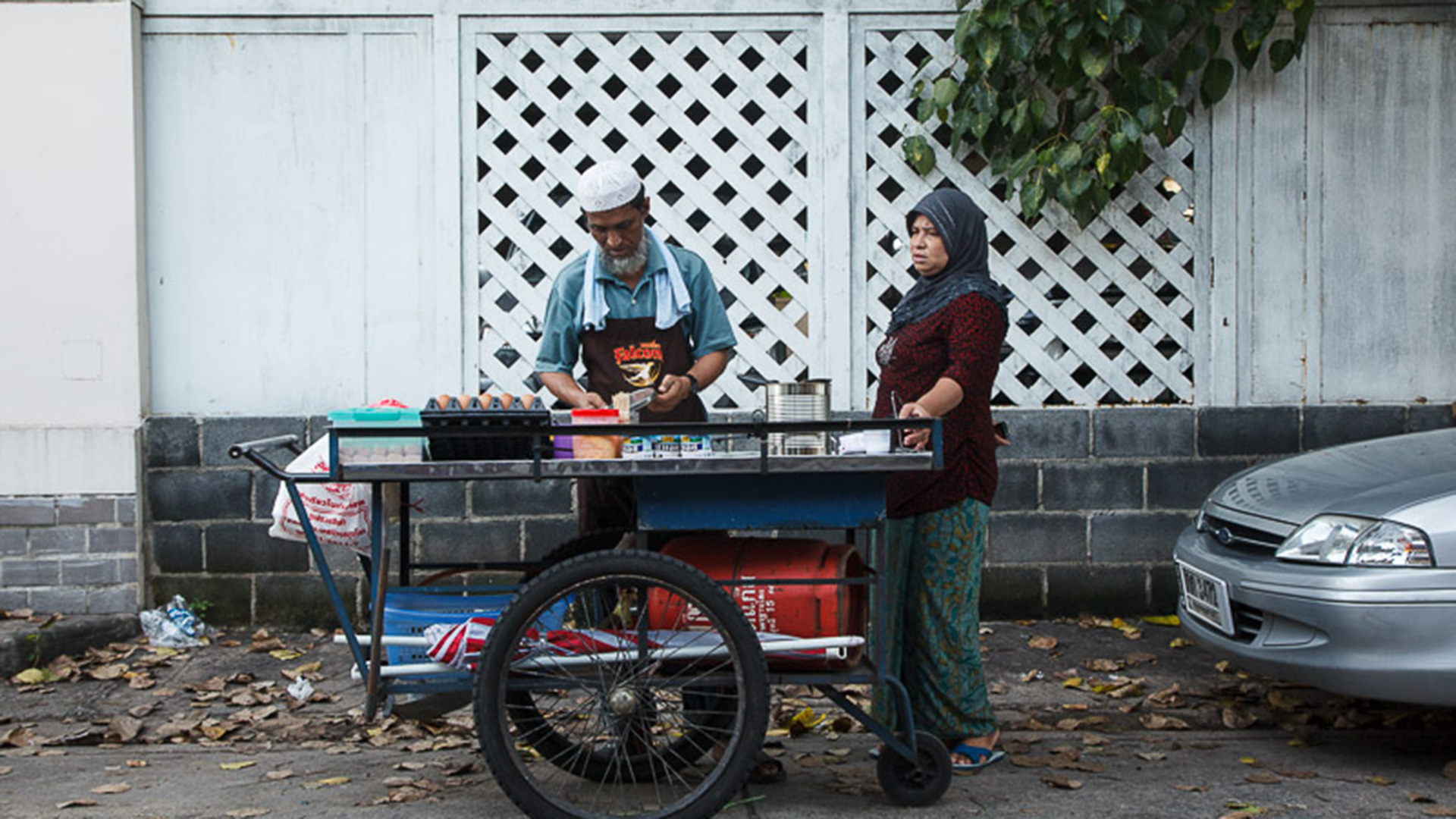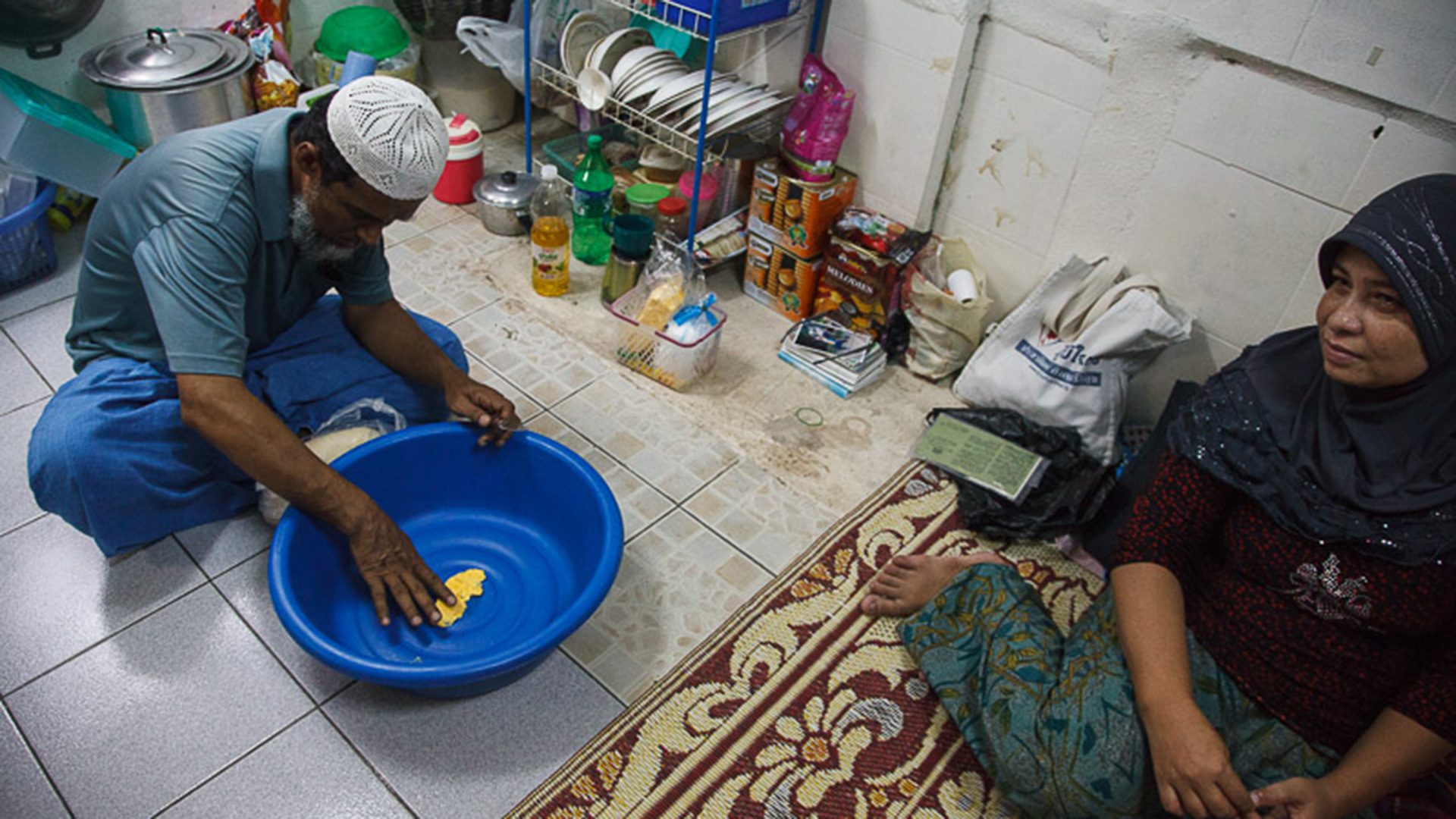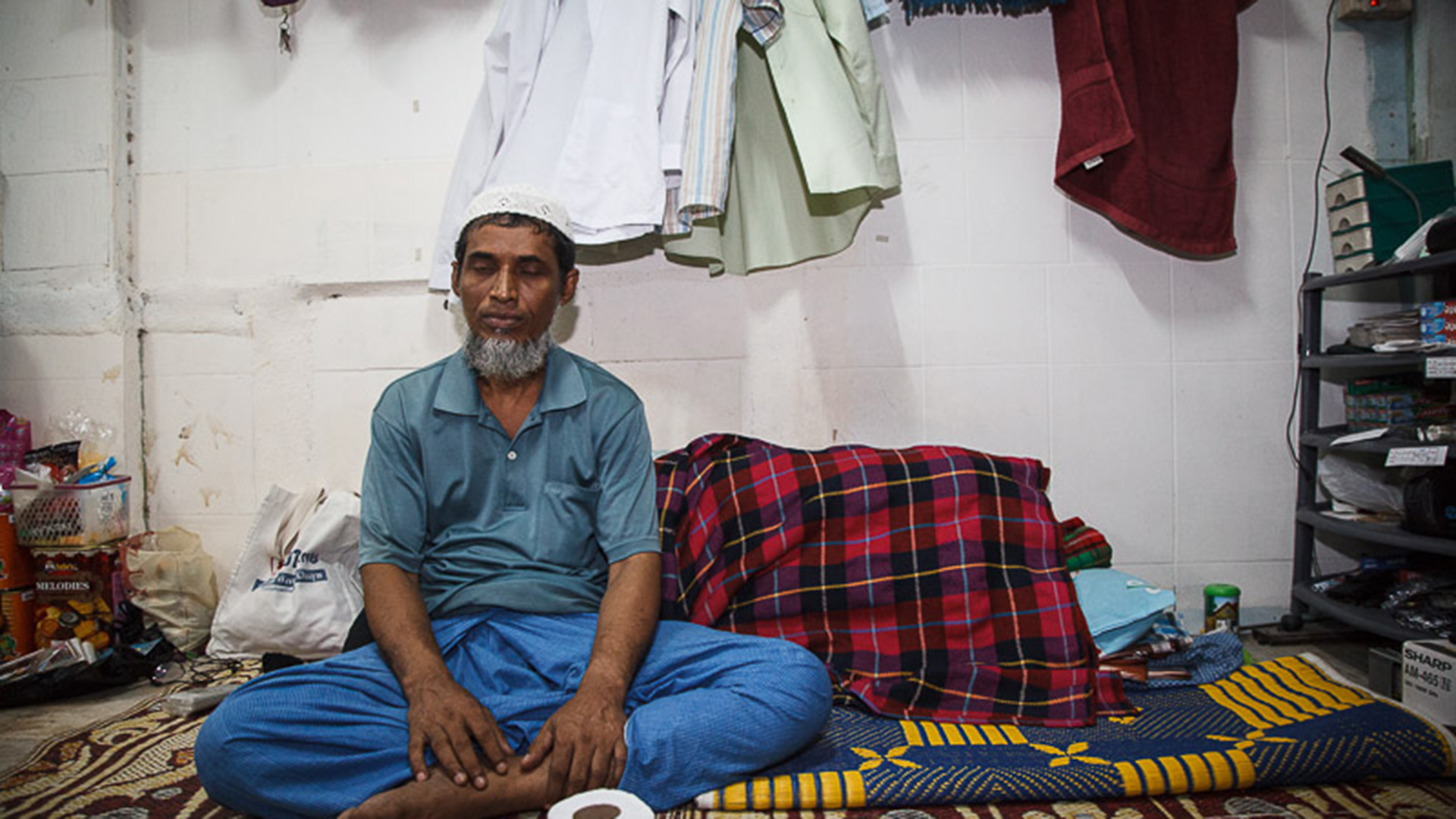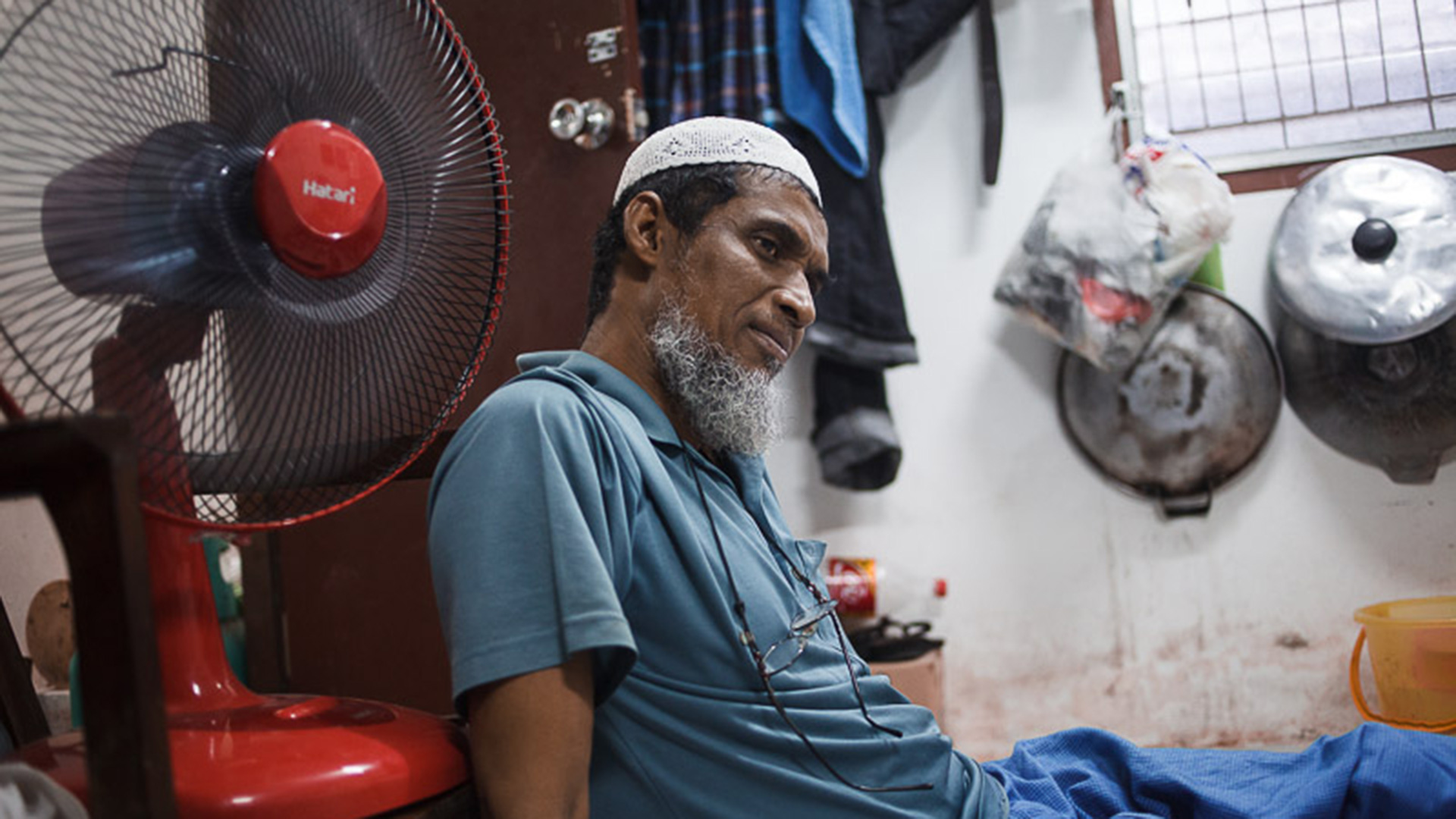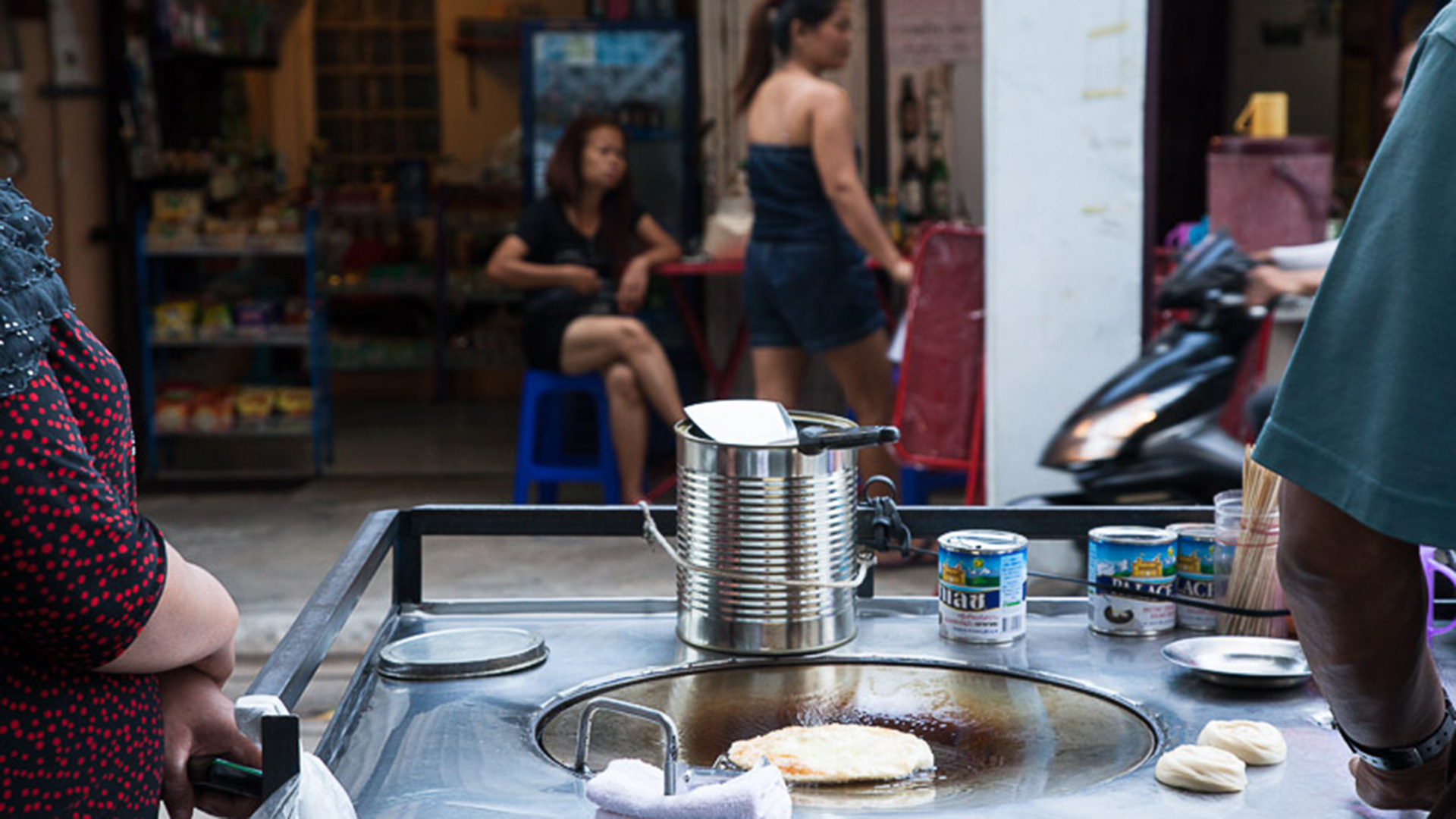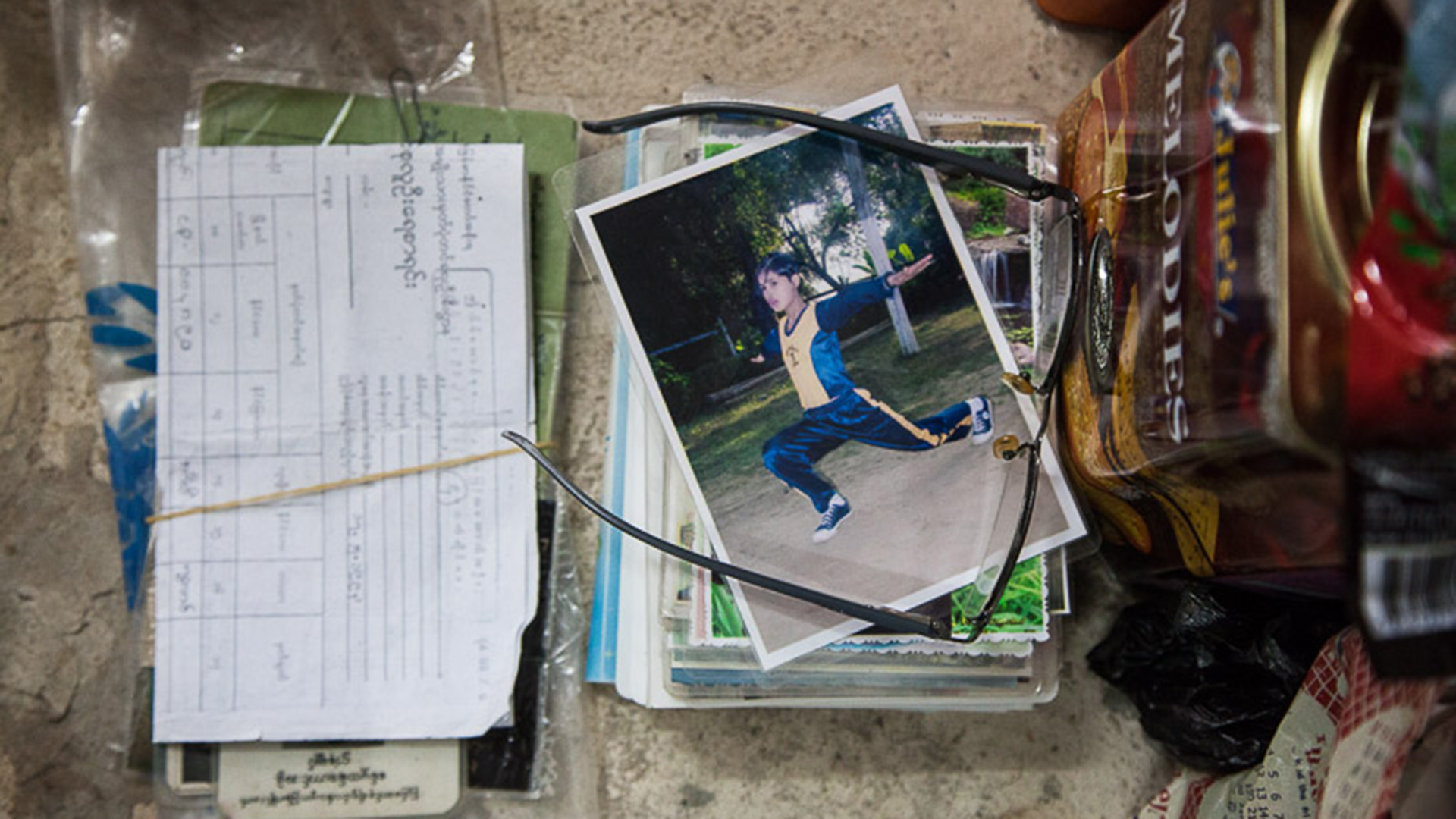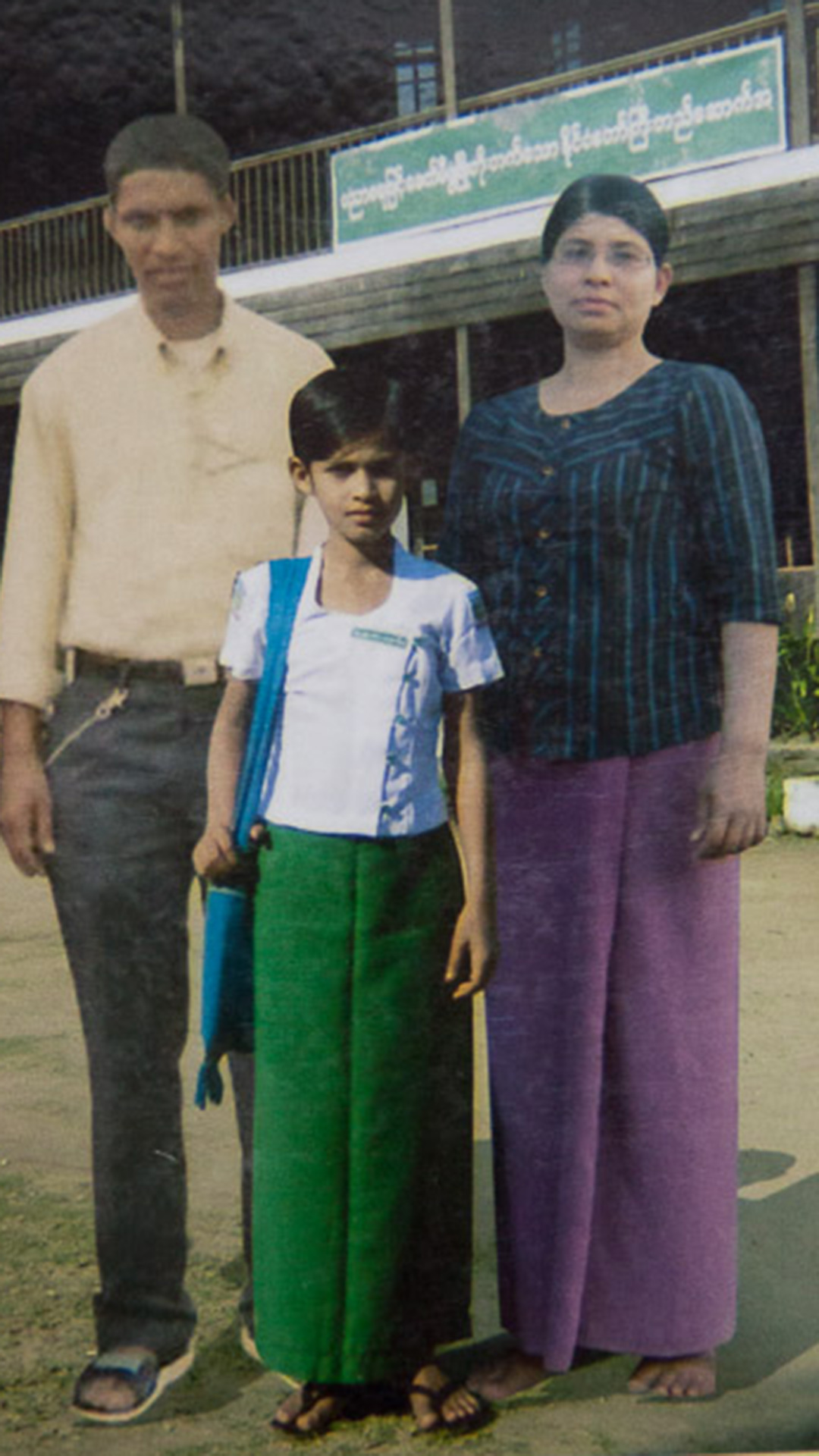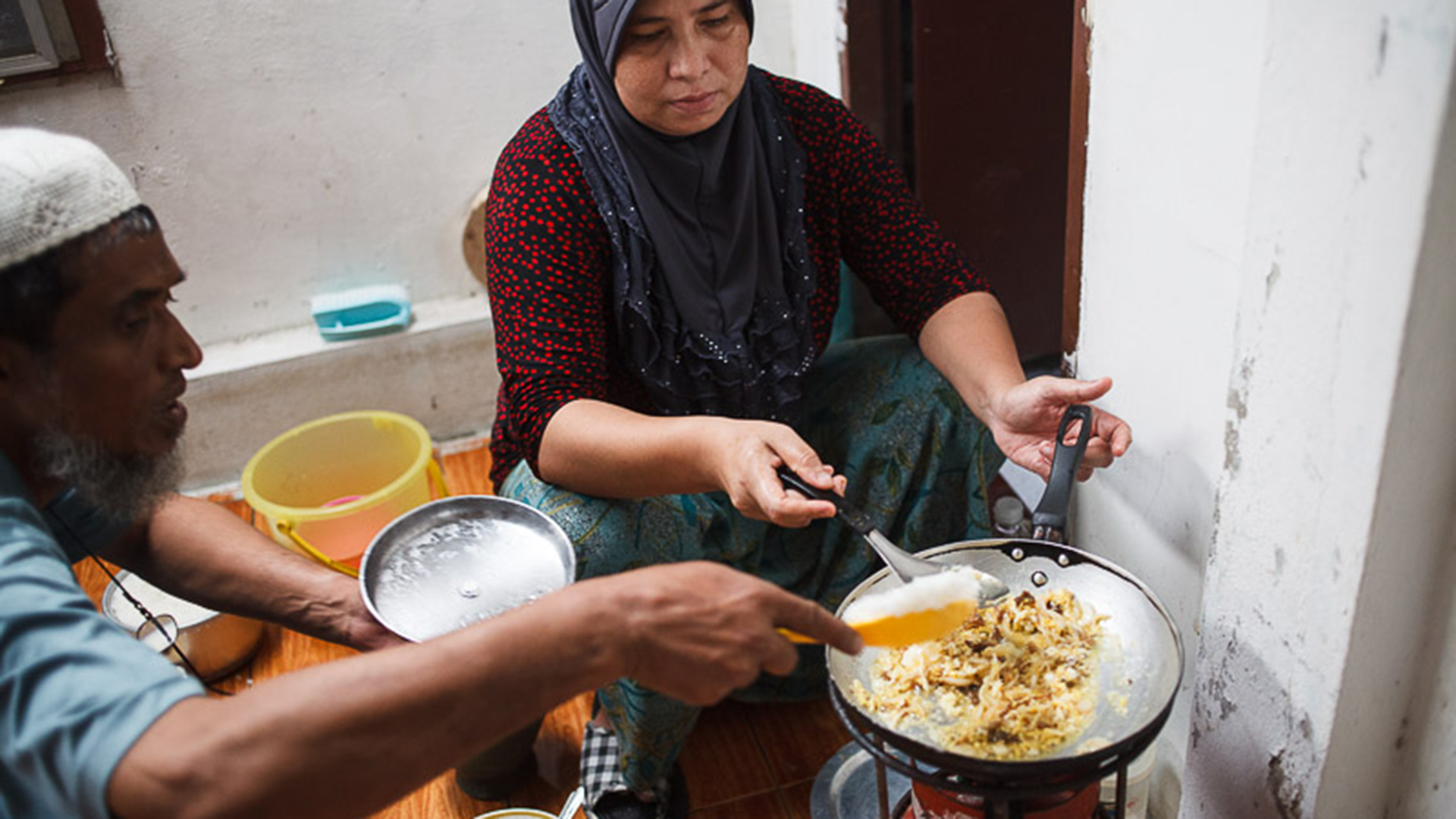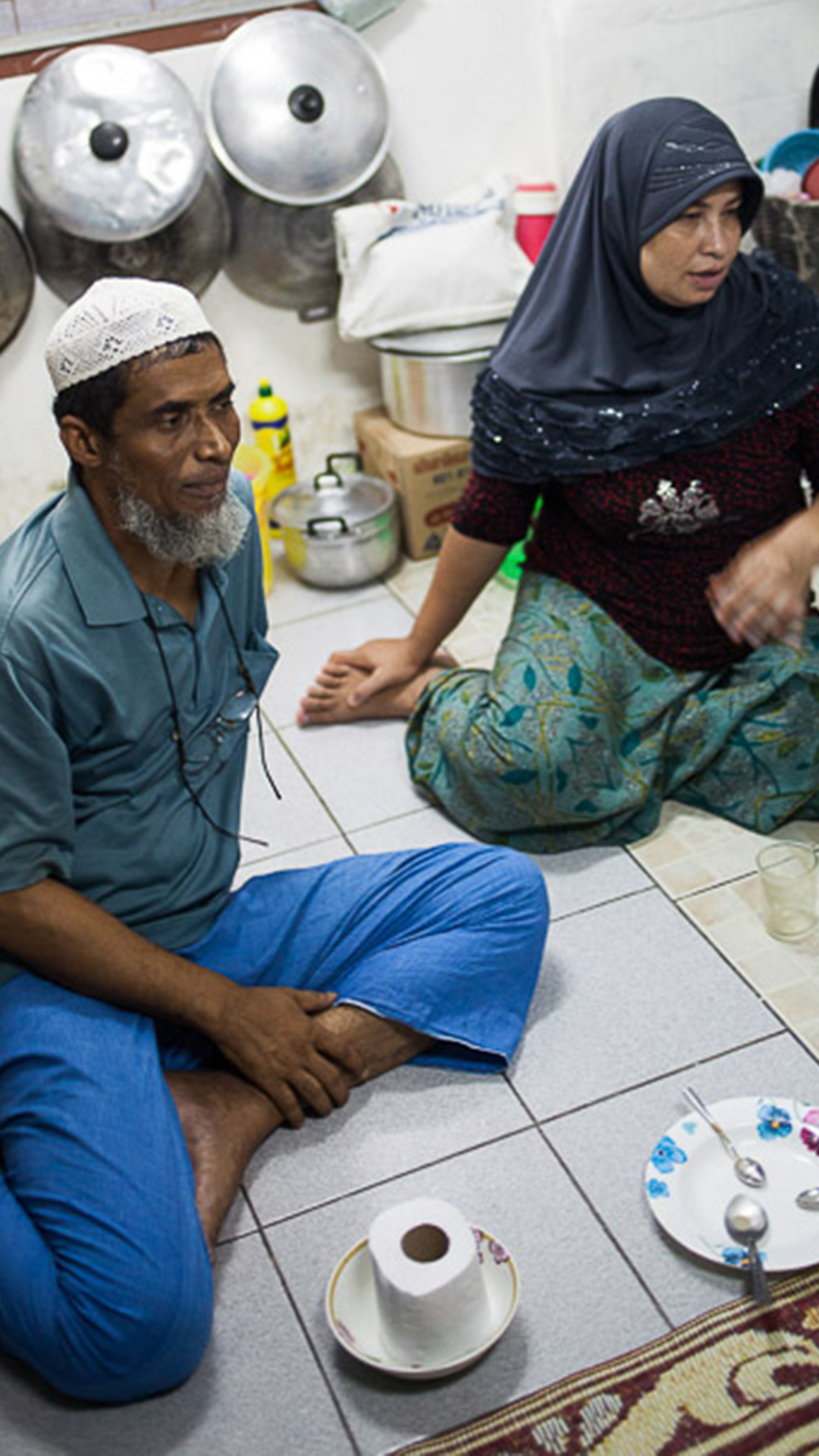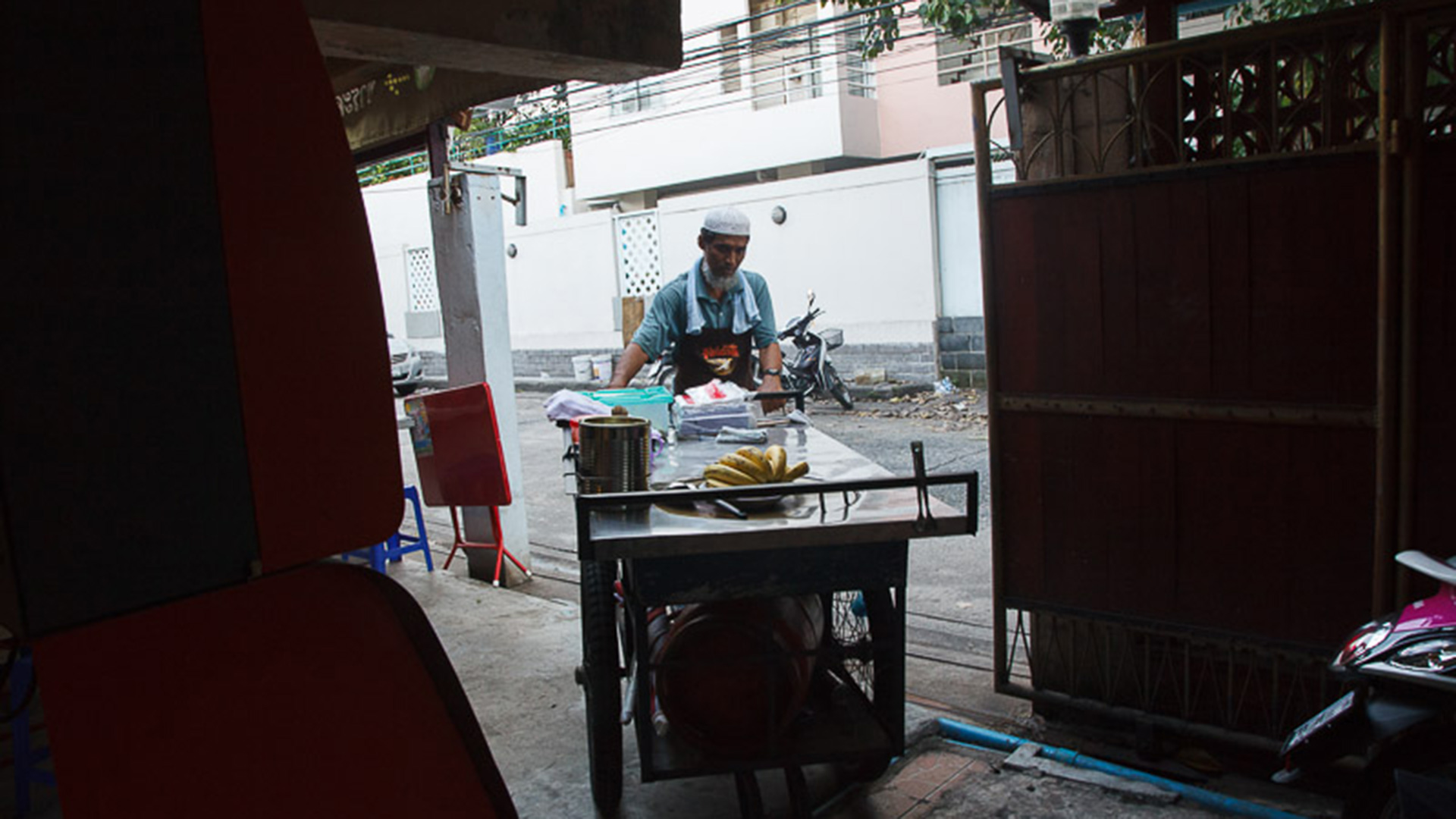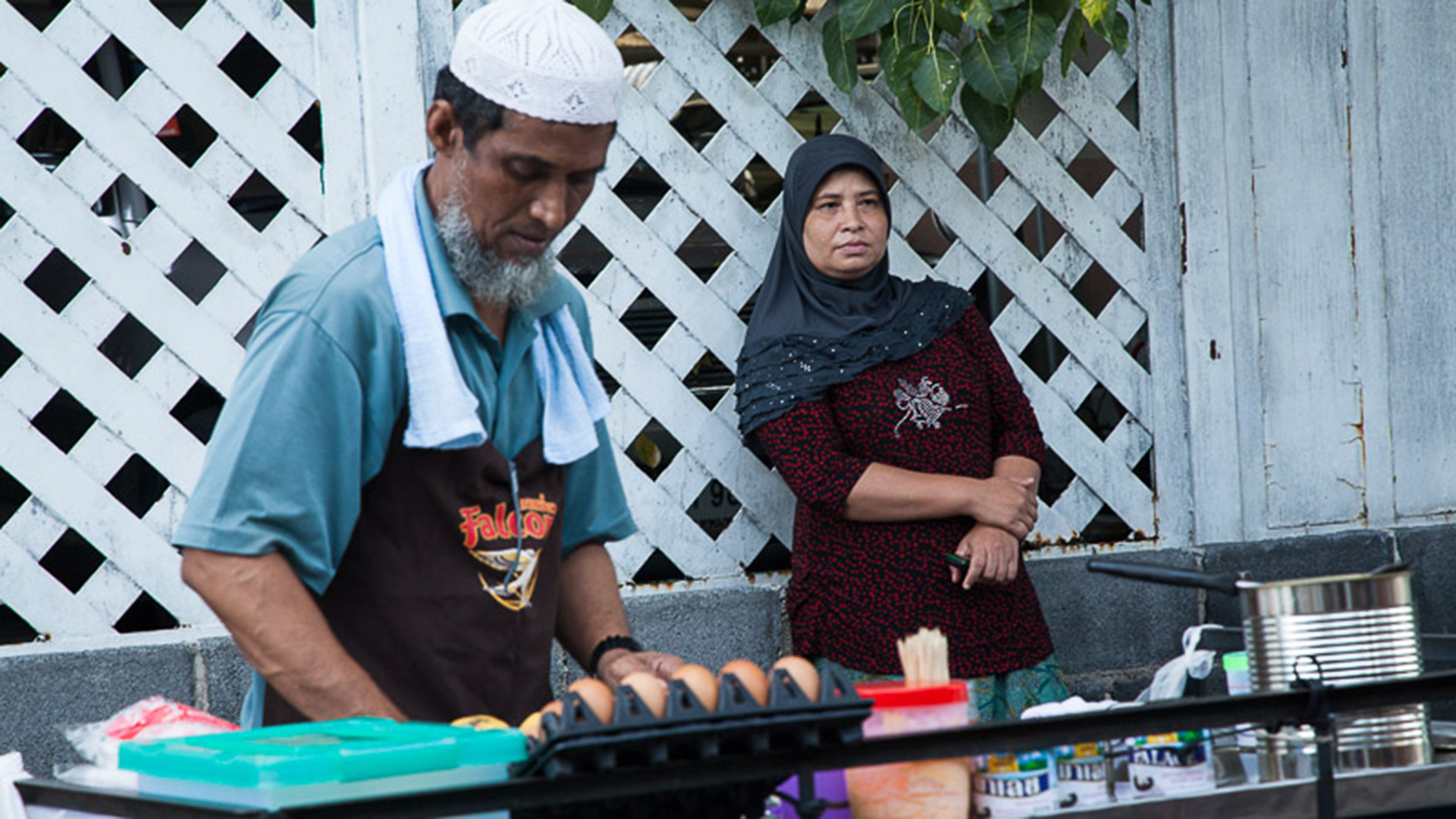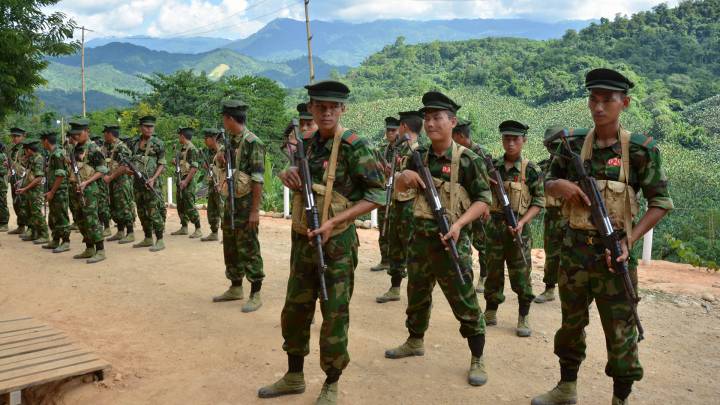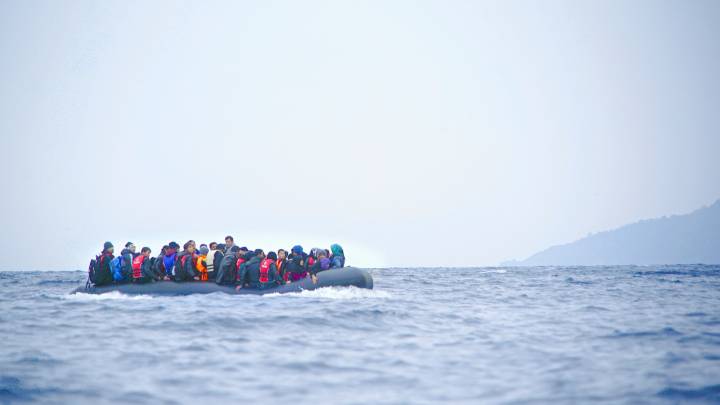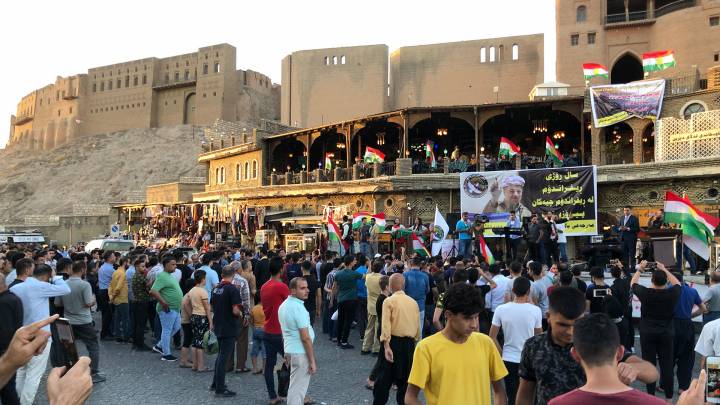Few conflicts have shaken the Islamic world as deeply as the one surrounding the Rohingya, Myanmar’s Muslim minority. U Kyaw Thien and his wife escaped to Thailand – but had to leave more than their belongings behind.
“There is no place for us. Nowhere,” says U Kyaw Thien, as though trapped in a nightmare that refuses to end. He looks down and pours a little flour, water and butter into a blue bowl.
He and his wife Alima live in a quiet Bangkok side street, sharing one small room which they sublet in a single-storey house. They don't attract attention in the towering, vibrant metropolis. More than 14 million people live in Thailand's capital – nobody here asks them where they are from. It's midday and the sun is beating down on the city. Still, U Kyaw Thien and Alima have to switch on the fluorescent light in their room. The window is too small to let in enough daylight.
U Kyaw Thien is a calm, soft-spoken man in his early fifties. He wears a longyi, the traditional Burmese skirt worn by both men and women, fastened around his hips. Alima sits near him on the carpet. She is staring fixedly at a stack of photographs – pictures of their daughter.
It looks like a room someone has just moved into, but U Kyaw Thien has lived here for 17 years They have arranged cooking utensils and a couple of cupboards in the small room. They place their blankets and pillows to one side during the day, shirts and prayer mats are hung up on the walls. The gas cooker is just outside the door. In the background, a silent television flickers. Suitcases are piled in a corner. It looks like a room someone has just moved into, but U Kyaw Thien has lived here for 17 years. Alima joined him in 2012. They were both forced to flee their home in Myanmar and were unable to bring their daughter.
U Kyaw Thien and Alima were born in a small village in a western province which at the time was called Arakan. Their parents belonged to a Muslim population which has maintained its own language and distinct culture – the Rohingya. The origin of the Rohingya is fiercely disputed. While they see themselves as the original inhabitants of their region, many Burmese regard them as illegal immigrants from Bangladesh and refer to them as Bengalis.
Arab merchants have frequented the country to the east of the Bay of Bengal since antiquity, and there is evidence that the Rohingya could have begun to settle in the largely Buddhist region as early as the eighth and ninth centuries. During British colonial rule (1823-1948), settlement was intensified by workers from areas that are now parts of India and Bangladesh.
The first mass exodus occurred during a brutal military operation in 1978, when around 200,000 Rohingya fled to neighbouring Bangladesh.When Burma won its independence from British rule in 1948, more than 130 distinct ethnic groups were part of the Union of Burma, but the Rohingya received no official recognition – they were to be systematically excluded from the new state. After only a few years, the military seized power. The military dictatorship would become one of the world's most brutal regimes. The Rohingya had already been suffering under manifold inhumane repression from 1948 onwards. Holy sites, infrastructure and residential areas were destroyed, and private land was confiscated. Through the imposition of travel restrictions and language barriers, it became difficult for the Muslim ethnic group to access schools and hospitals. Arbitrary incarceration, illegal taxation and forced labour were not uncommon; many were tortured, some killed. The first mass exodus occurred during a brutal military operation in 1978, when around 200,000 Rohingya fled to neighbouring Bangladesh.
The dictatorship has been there for as long as U Kyaw Thien can remember. He was three years old in 1962 when the army took over; discrimination was his everyday reality. In 1979 – one year after a large military operation that took the lives of friends – he left his village in Arakan. When he arrived in the then-capital Rangoon, he was excited. “I was still very young and I felt free for the first time,” he recalls. The army was recruiting, and Rohingya were also being accepted. ‘I applied straight away. I preferred to join the enemy rather than fight against them.”
U Kyaw Thien was 20 at the time. For the next 13 years he fought on the side of the brutal regime. In a skirmish with the Kechin, another ethnic group, he was wounded. At 33 and with war veteran status, he returned to his village. Now Arakan was called Rakhine, Rangoon was called Yangon, and Burma was called Myanmar. The army had given the country, the provinces and the cities Burmese names.
U Kyaw Thien kneads the ingredients in the blue bowl into a dough. The dough will be ready by evening, then he will stand on the street and sell roti bread to Thais. With the money he makes, he and Alima can afford a modest life.
The dough still has to rise a bit. He washes his hands, then rummages through one of the cupboards for documents. He pulls out a laminated white ID. A young man gazes earnestly out of the photo.
“This is my White Card,” he explains, pointing at it. This National Temporary Registration Card states: “The bearer is not a citizen of Myanmar.” No birthplace is listed. U Kyaw Thien pulls out another White Card, on which a young woman is pictured. “That's Alima. I saw Alima for the first time after I went back to my village in 1992. I was helping out in my father's shop. She was working opposite, in her parents’ business.” They quickly fell in love. Alima was only 17 years old, so they had to wait another year until they could get married. “It was a happy time,” he reminisces fondly. Alima smiles self-consciously. Back then, U Kyaw Thien still had a war veteran card from his time in the military, which gave him special status.
After three years, the situation changed. Due to pressure from the UN, Rohingya began to be assigned identity papers too. Without documents they had no rights and no entitlement to protection. Via the many Rohingya refugees, who without passports often received no immigration status, the problem was spreading to neighbouring countries.
The military regime came up with the White Card for the Rohingya. Of course, few actually received the card: it was all to create the illusion of bowing to international pressure and finally legalising the Rohingya. Some had to be forced to accept the papers. They didn't want the document, because although it identified them, it also made it clear that they were not citizens of Myanmar.
Rohingya who want to move from one place to another have to apply for permission and pay the fees.In the context of this new development, U Kyaw Thien lost his war veteran status in 1996. His veteran's card was replaced with a White Card. “They took away all of my rights,” he remembers. In despair, he headed for Yangon, the city in which he had once felt so free. Doing this, he was disobeying the rules which now applied to him as well. Rohingya who want to move from one place to another have to apply for permission and pay the fees; only then may they leave their place of residence.
U Kyaw Thien hadn’t applied for anything. In Yangon, he heard the terrifying news: he was on the black list, for travelling without the appropriate papers. If Rohingya don't have permission to travel or deviate from the prescribed route, they are forbidden to return. They are then obliged to leave Myanmar, or else they will be incarcerated.
With the help of a people smuggler, in 1996 U Kyaw Thien hid in a truck bound across the national border to Mae Sot in Thailand. Alima, who remained behind in the village, was sick with worry. The last thing she had heard about her husband was that the army was looking for him. With financial support from other Rohingya refugees, U Kyaw Thien made it to Bangkok, where for the first time since his flight he had the opportunity to contact his wife. It was then that he learned she was pregnant.
U Kyaw Thien reaches for a stack of photos lying in front of Alima. “This is Suemaya, our daughter,” he says, looking wistfully at the pictures. One is of a three-year-old girl. In another she is wearing school uniform. Another picture shows her standing next to her mother. “I've never seen her,” U Kyaw Thien says quietly. But in one picture, he, Alima and Suemaya are all together. “There I was pasted in with the computer,” he laughs, slightly embarrassed. He continues more seriously. “This is the only family photo of us that exists.”
Keeping in touch was not easy. “We wrote each other letters and sent photographs,” Alima recalls. “Telephoning was difficult. I had to walk two hours from my village to the nearest city if I wanted to give U Kyaw Thien a phone call.” Because of the travel restrictions, Alima also had to apply for travel authorisation every time. “Sometimes I didn't have enough money, but sometimes I was also able to take Suemaya with me into the city for a phone call,” she says, while she looks at the pictures. “Those were beautiful moments, when I heard my daughter talking to her father.”
Later, during the first reforms, communication became a little easier. One reform, for example, permitted mobile phones.
Myanmar went through an unstable period at the beginning of this century. The so-called Saffron Revolution, started by monks in 2007, was initially directed against the 500 per cent rise in petrol and gas prices, and then broadened to protests against the regime in general. The demonstrations, in which more than 100,000 people took part, were violently suppressed; unofficial observers talk of over 200 people killed. Unlike the 1988 revolution, which underwent similar bloody repression, this time the events did not remain unobserved. Although the junta cut off Internet access, pictures and video footage reached the international media.
International pressure grew; the regime knew that it couldn't withstand the sanctions any longer. In 2010 the first elections in forty years took place, and Nobel Peace Prize recipient Aung San Suu Kyi was released from house arrest. As a sign of goodwill, more White Cards were given out to the Rohingya, but they were not allowed to participate in the elections.
The elections, which were neither free nor fair, were declared invalid a short time later and held again in 2012. Since then there have been incremental reforms, and Aung San Suu Kyi's party, the National League for Democracy (NLD) –the sole opposition party – gained seats in parliament for the first time.
Of the 800,000 Rohingya living in Myanmar, around 110,000 were displaced within the country, and others fled across the border.The Rohingya hoped they would also see positive changes to their situation. For them, just as for the Burmese, Suu Kyi is a symbol of human rights and democratic freedom. Yet for the Rohingya, nothing changed for the better. In fact, things got worse. In Rakhine State – formerly Arakan – in April 2012, a Buddhist girl was found dead. Three Muslim men were accused of murder. A revenge campaign began, marking the beginning of bloody clashes between Muslims and Buddhists in the province. Over 200 people on both sides died, houses were burned down and holy sites were destroyed. Of the 800,000 Rohingya living in Myanmar, around 110,000 were displaced within the country, and others fled across the border. In many cities they live in ghetto-like neighbourhoods, without access to food. Their legal persecution was sharply intensified.
Since the incident, nationalist groups have made large gains, in particular the 969 Movement. The name of the group is a sort of Buddhist variation on a conspiracy theory: in a country in which belief in the power of numbers is strong, 969 allegedly represents the cosmological opposite to the spiritually-loaded number 786 in the Koran. 969 relates to the nine attributes of the Buddha, the six attributes of his teachings and the nine attributes of the Sangha, the monastic rule.
Predictably, the 969 Movement sees itself as responsible for protecting Buddhist Myanmar. The movement's head is Wirathu, a Buddhist monk. In April 2013 in a monastery in the south of the country, the 969 logo was created and then distributed everywhere. The movement took hold across the country and began targeting Muslims. 969 stickers decorate businesses, taxis and even police cars. They are a sign of Buddhist belonging and imply that Muslims are not welcome.
Many Burmese say they are afraid of losing their Buddhist identity. Encouraged by the local media, they believe that Rohingya are entering the country across the Bangladeshi border on a daily basis. According to prejudice, Muslim men have many wives, who have many children – too many. In addition to the religious aspect, there is the darker skin of the Rohingya, and the military regime has connected the Rohingya to the British invasion. Prejudices passed down through generations are not so easily laid aside.
One of the junta's key strategies was to create unrest in order to then bring order, as orchestrated proof of the necessity of the dictatorship. There are suspicions that the current unrest is also motivated by political strategy.
For Aung San Suu Kyi the conflict is a major dilemma: if she takes up the Rohingya cause, she will alienate her Burmese supporters, but if she remains silent, she will lose her international credibility as a human rights activist.Even Aung San Suu Kyi initially had no stance on allegations of human rights violations against the Rohingya. For her, the conflict is a major dilemma: if she takes up the Rohingya cause, she will alienate her Burmese supporters, but if she remains silent, she will lose her international credibility as a human rights activist. In May 2013, the 68-year-old spoke out for the first time against attempts to introduce a two-child policy targeting the Rohingya.
In Yangon, the commercial capital, 969 stickers are seen less frequently than in other cities, and the roadblocks that separated some Muslim neighbourhoods from each other have been taken down. It reflects poorly on Myanmar if the conflict is too public, too visible. One of the many regions of Myanmar that are still off-limits is Rakhine State. Permission to travel is hard to get, and international reporters are not welcome. Alima describes the situation: “If a Rohingya speaks with a foreigner in Rakhine, he can end up in jail.”
In 2012 Alima was visiting friends in Yangon. Her daughter could not accompany her; there wasn't enough money for two travel permits. Moreover, Suemaya had to go to school, so she remained in the village with her grandmother. Alima had only intended a brief visit. With the outbreak of unrest in April, travel restrictions were immediately tightened and Rohingya had to stay wherever they happened to be at the time. Alima caught word of targeted attacks, even in Yangon. She no longer felt safe, but couldn't return to the village. Fearing for her life, she borrowed money to pay a people smuggler and fled to join her husband in Thailand.
U Kyaw Thien and Alima saw each other again for the first time in 16 years. Yet the joy of the reunion was marred by their worry about Suemaya, who had to be left behind. “We live with fear in our hearts,” says U Kyaw Thien. They are not allowed to return. They can't afford to pay the people smugglers to bring their daughter to them. And escaping from Myanmar is dangerous.
Suemaya now lives with her grandmother. “She must finish high school now, that's what counts,” says Alima, as though to calm herself. Sometimes her face brightens suddenly – when she says how her daughter likes physical education classes, or how pretty she looks in a dress – but soon her usual burdened look returns.
Alima quickly fries a bit of rice on the small gas stove for U Kyaw Thien. The sun slowly descends. It is evening. U Kyaw Thien takes off his longyi and puts on a pair of jeans and an apron with Thai writing. In the longyi he would be too conspicuous, and potentially recognised as an immigrant from Myanmar. U Kyaw Thien and Alima are in Thailand illegally. How many Rohingya are living in Thailand is difficult to determine. There are some 20,000 to 30,000 in refugee camps, but the number of clandestine Rohingya is incalculable.
U Kyaw Thien rolls his roti cart out onto the street. Soon the first customer arrives to order a roti with banana and sweet milk. Alima stands beside him and helps where she can. In her mind she is with her daughter.
This article originally appeared in German in the 1/2014 edition of zenith Magazine. Translation by Joel Scott.
Sandra Weller studied photography in Maastricht and now lives in Berlin. She lived in Thailand and Indonesia for three years. Her photographic work concentrates mainly on social issues. www.sandrawellerfoto.com
